<<PREVIOUS -
HOME -
CONTENTS -
NEXT>>
QSI -
![]()
<<PREVIOUS -
HOME -
CONTENTS -
NEXT>>
QSI -
![]()
The large CCD sensor of the QSI 532ws-M1 camera has increased the importance of flat field calibration. Also, flat field calibration is required for calibrated images to be used for measurements such as photometry.
The purpose of flat field calibration is to remove image sensor pixel differences and to remove optical affects such as dust spots, vignetting, etc. Taking a flat field calibration image is one way to reduce vignetting.
Flat Field Calibration Source of Light A stable uniform source of light is the key for creating a good flat field calibration image. It occurred to me that the solution was in front of me. It was the HP Pavilion dv6000 laptop computer LCD monitor or the 17 inch Sharp LL-T17A3-H LCD monitor connected to the secondary display port of the HP dv6000 laptop. So I aimed my Pentax 75 mm refractor at the LCD and adjusted the desktop gray brightness to obtain approximately 50% illumined flat frame image using a 2 second exposure with the QSI 532ws-M1 camera.
You take several flat frames and several flat darks frames at the same exposure and temperature. The flat frames are taken at same focus position and camera to telescope position as the image frames. You combine the flat darks frames into a master flat dark frame and subtract the master flat dark frame from each flat frame to obtain calibrated flat frames. Next you combine the calibrated flat frames into one master calibrated flat that will be used to calibrate your images.
The challenge is a stable uniform source of light. Any defects in the light source will cause defects in the image frame that is being flat field calibrated.
One way to test the quality of the flat frame light source is to create a master flat frame and then create a second master flat frame with the telescope or light source rotated 90 degrees. I my case it is very simple to rotate the Pentax 75 mm refractor by 90 degrees. You use one master flat as the test image and use the second master flat as the flat field calibration image.
A good flat field calibrated test image is a uniform noisy image with no dark or light areas. A good test image histogram is a normal probability distribution. The normal probability distribution is caused by at least three types of noise that are in the master flat field frame and the test image. The noise sources are photon noise, dark current noise and readout noise. A non-uniform light source causes dark or light areas in the test image.
In a real world example there are degrees of improvement. My test images are not uniformly white but they are an improvement over not using the flat field calibration. And, they are very simple when using the laptop LCD as the light source.
Flat Frame Using the HP Pavilion dv6000 Laptop LCD Monitor
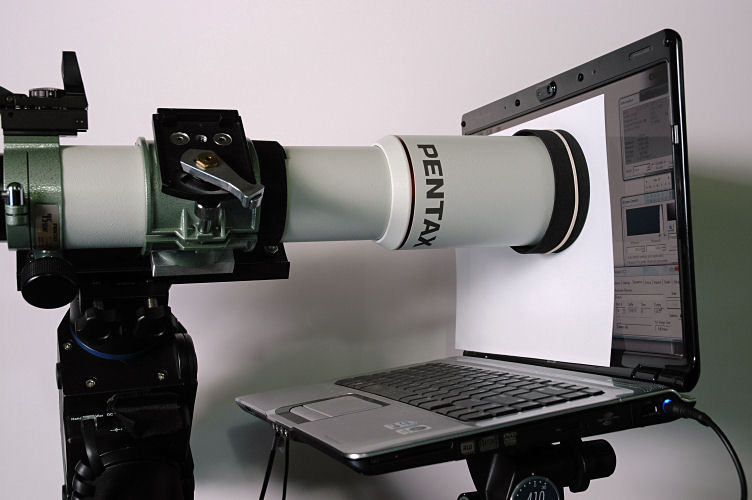
The above photo shows using the HP dv6000 laptop as the flat field light source at same time controlling the QSI 532ws-M1 camera. A piece of white plastic is put between the Pentax 75 mm refractor dew shield and the laptop LCD to diffuse the light. The pressure between the refractor dew shield and the laptop LCD holds the white plastic in place. I made sure no program windows were in the area used by the telescope and the desktop area was clear with only white background on the desktop.
I have a strip of black craft foam held with a rubber band to use as a light seal between the Pentax 75 mm refractor dew shield and the LCD monitor.
The benefit of using the laptop LCD as the light source is that it has been on for awhile being used for taking images and it will be at a stable temperature.
The photo shows the Pentax telescope in the normal position. To test the quality of the flat frames the Pentax telescope was rotated 90 degrees clock wise to take a separate set of flats to test the quality of the flats.
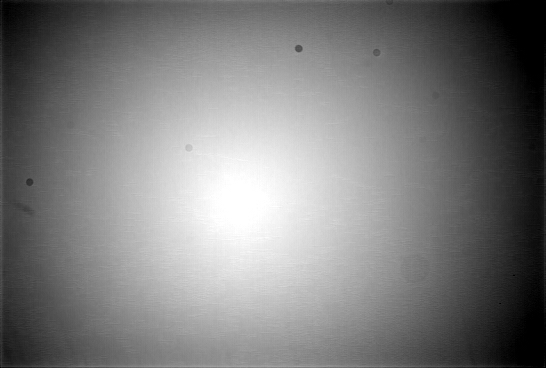
The above image is a master flat frame when the telescope is in the normal position taking flat field calibration using HP DV6000 laptop as the light source. The flat field image is reduced by 25% for display purposes. 43 flat frames and 34 dark frames were used to create this master flat frame.

The master flat frame histogram using AIP4WIN and data (histogram.txt). Notice the few pixels that have below normal sensitivity on the left side of the histogram. Notice the maximum 33203.6 and minimum 18910.11 has a range of 14293.49 which is about 54.9% of the maximum and minimum average.
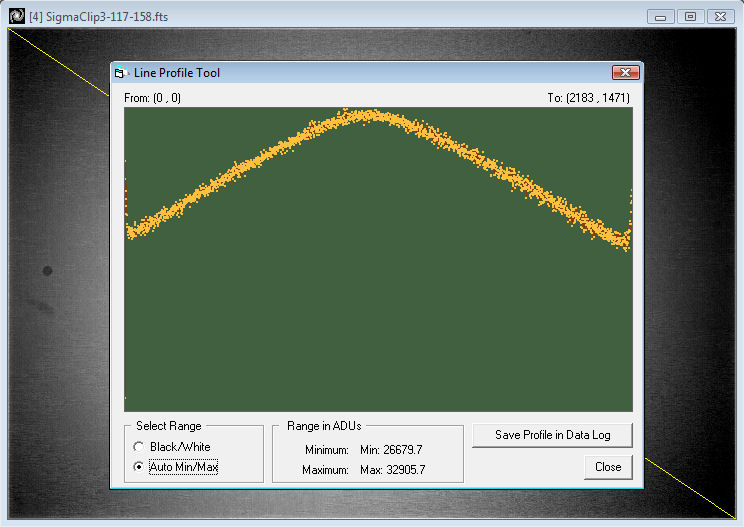
The master flat frame line profile using AIP4WIN. Notice the maximum 32905.7 and minimum 26679.7 has a range of 6226 which is about 20.9% of the maximum and minimum average.
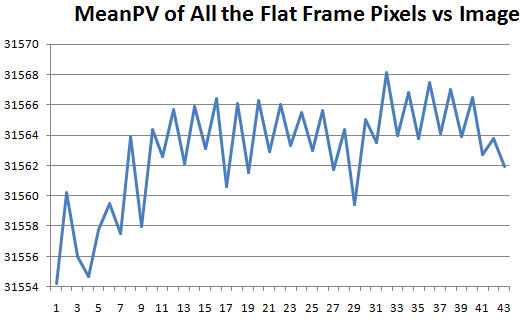
The above mean pixel chart shows the mean pixel value of the 43 flats that were taken over 3 minute time frame. The mean pixel value show how stable the LCD light source was during taking the 43 flats. The range of the mean pixel value is 13.9 and the mean of all 43 mean pixel values is 31562.95. This is a small 0.044% change over the 3 minutes time that the 43 flat frames were taken.
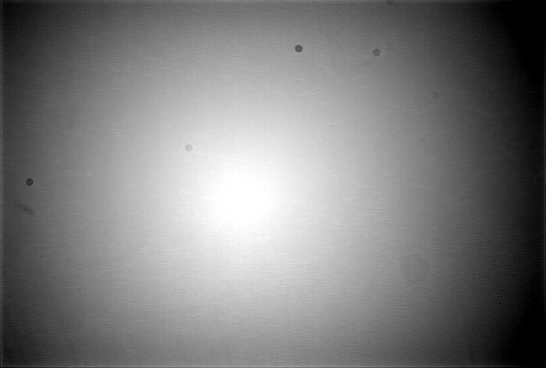
To test the quality of the flat light source the telescope is rotated 90 degrees clock wise from the normal position. The flat field calibration uses the HP DV6000 laptop as the light source. The flat field image is reduced by 25% for display purposes. 43 flat frames and 34 dark frames were used to create this master flat frame.
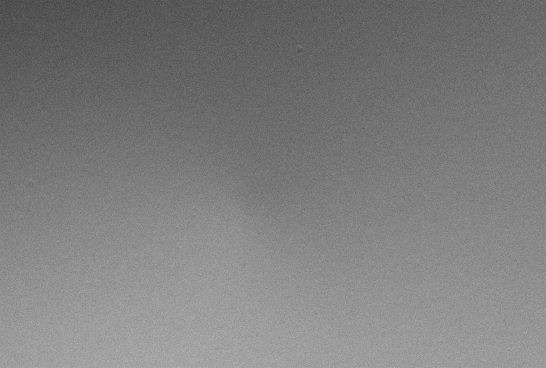
The normal position flat field image was use to calibrate the rotated flat field image. The calibrated image is reduced by 25% for display purposes. The calibrate image is an improvement over not using the flat field calibration image.
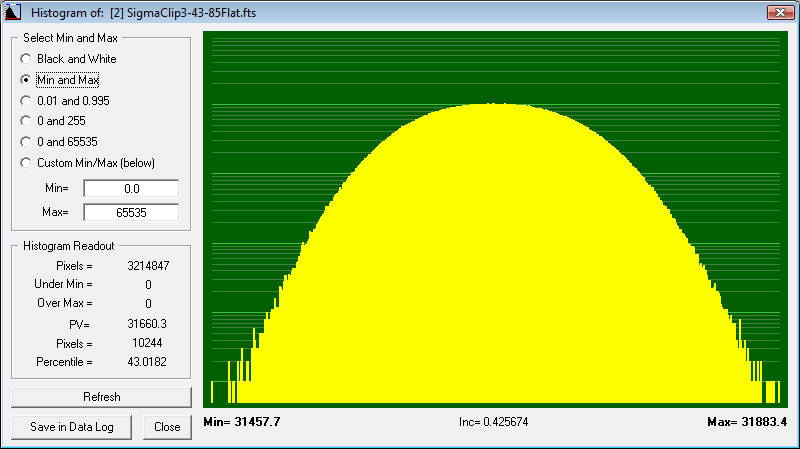
The calibrated frame histogram using AIP4WIN and data (logCalFlat.txt). Notice the nice bell shape of the calibrated image and the few pixels that had significant below normal sensitivity are now taken care of. Notice the maximum 31883.4 and minimum 31457.7 has a range of 425.7 which is about 1.3% of the maximum and minimum average.
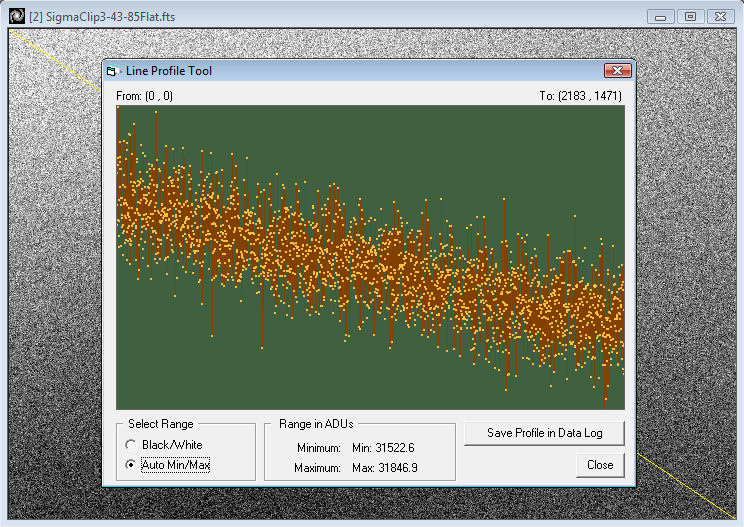
The calibrated frame line profile using AIP4WIN. Notice the maximum 31846.9 and minimum 31522.6 has a range of 324.3 which is about 1% of the maximum and minimum average.
Flat Frame Using the Sharp LL-T17A3-H LCD Monitor
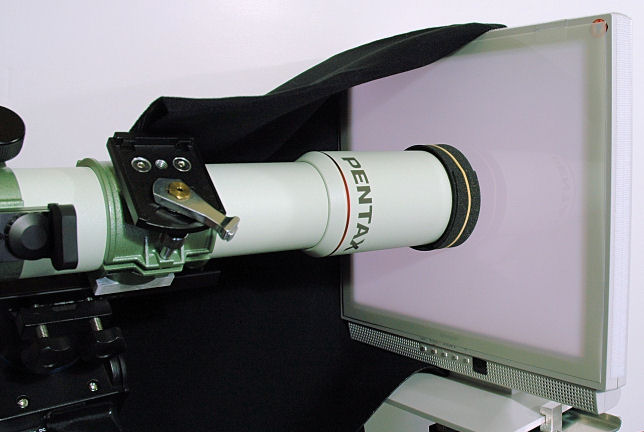
The above photo shows the 17 inch Sharp LL-T17A3-H LCD monitor that is connected to the HP dv6000 laptop secondary display port being used as flat frame light source.
I made a box cover for the Sharp LL-T17A3-H LCD monitor and the front of the telescope using black stiff paper so that it would not have light leaks affecting the flat field calibration image. Also, covered it would be more star party friendly. This turned out to be a mistake. The box kept the LCD monitor heat inside and the light level of the LCD dropped as the LCD temperature increased. Now I just cover the front of the monitor with black cloth that sticks to white Velcro tape that was put on the edge of the Sharp monitor.
I had a piece of thin white plastic that I tapped to the Sharp LCD to diffuse the LCD light. I have a strip of black craft foam held with a rubber band to use as a light seal between the Pentax 75 mm refractor dew shield and the LCD monitor.
The Sharp LCD monitor or laptop sits on a Bogen tripod so that it can be placed in front of the Pentax 75 mm refractor on the Orion Sirius mount.
The original tests were with the LCD 24 inches from the front of the Pentax 75mm refractor. But, now I have moved the LCD monitor up next to the Pentax 75mm refractor dew shield. This reduces light leaks that could affect the flat field image.
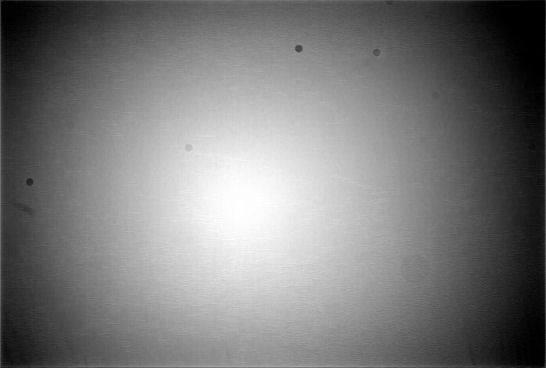
The above image is a master flat frame when the telescope is in the normal position taking flat field calibration using Sharp LL-T17A3-H LCD Monitor as the light source. The flat field image is reduced by 25% for display purposes. 101 flat frames and 101 dark frames were used to create this master flat frame.
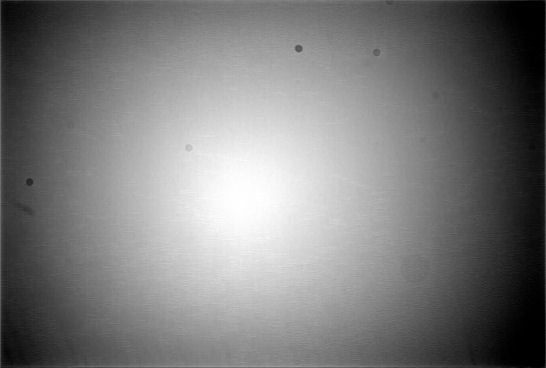
To test the quality of the flat light source the telescope is rotated 90 degrees clock wise from the normal position. The flat field calibration uses the Sharp LL-T17A3-H LCD Monitor as the light source. The flat field image is reduced by 25% for display purposes. 101 flat frames and 101 dark frames were used to create this master flat frame.
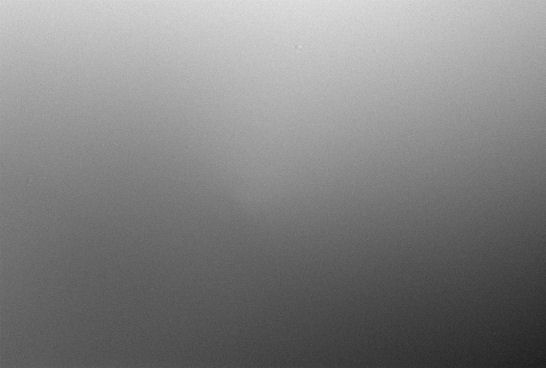
The normal position flat field image was use to calibrate the rotated flat field image. The calibrated image is reduced by 25% for display purposes. The calibrate image is an improvement over not using the flat field calibration image.
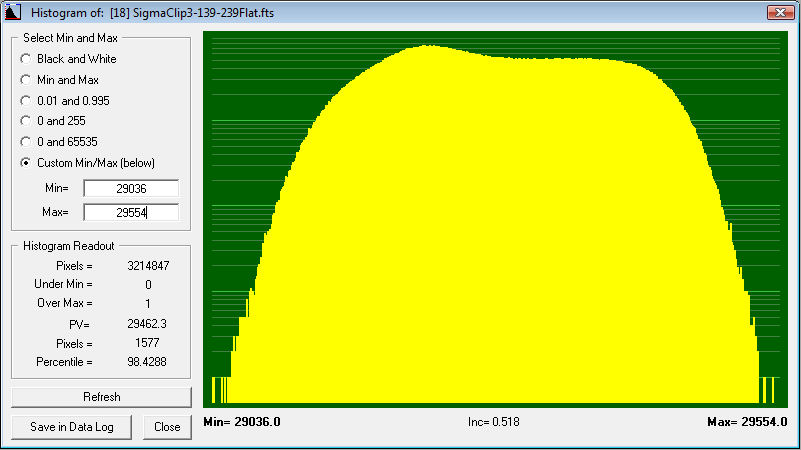
The calibrated frame histogram using AIP4WIN. Notice the maximum 29554 and minimum 29036 has a range of 518 which is about 1.8% of the maximum and minimum average.
Flat-Field Frame Calibration Links
Light Box Links
Adirondack Flat Fielder Links